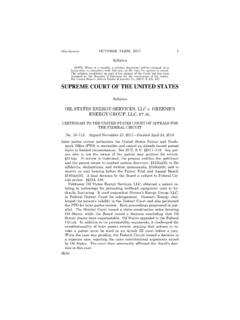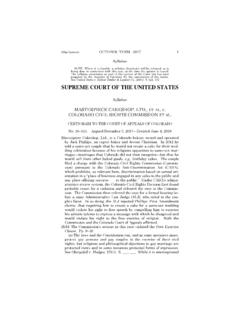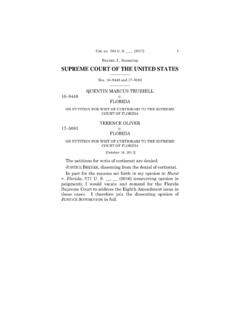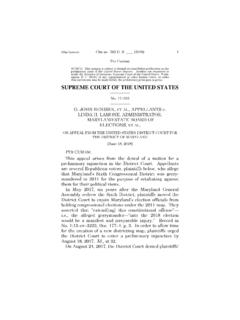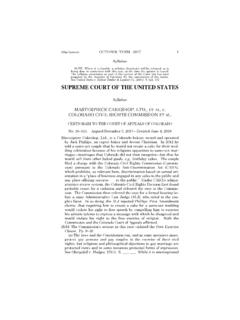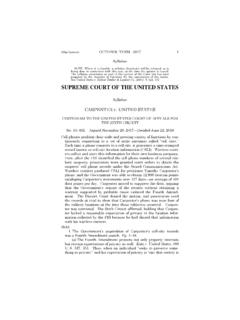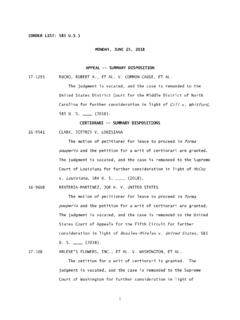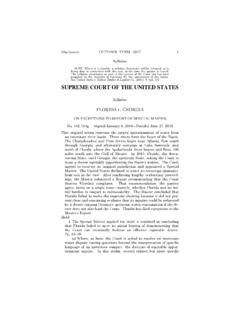Transcription of SUPREME COURT OF THE UNITED STATES
1 (Slip Opinion) OCTOBER TERM, 2014 1. Syllabus NOTE: Where it is feasible, a syllabus (headnote) will be released, as is being done in connection with this case, at the time the opinion is issued. The syllabus constitutes no part of the opinion of the COURT but has been prepared by the Reporter of Decisions for the convenience of the reader. See UNITED STATES v. Detroit Timber & Lumber Co., 200 U. S. 321, 337. SUPREME COURT OF THE UNITED STATES . Syllabus obergefell ET AL. v. HODGES, DIRECTOR, OHIO DEPARTMENT OF HEALTH, ET AL. CERTIORARI TO THE UNITED STATES COURT OF APPEALS FOR. THE SIXTH CIRCUIT. No. 14 556. Argued April 28, 2015 Decided June 26, 2015*. Michigan, Kentucky, Ohio, and Tennessee define marriage as a union between one man and one woman. The petitioners, 14 same-sex cou- ples and two men whose same-sex partners are deceased, filed suits in Federal District Courts in their home STATES , claiming that re- spondent state officials violate the Fourteenth Amendment by deny- ing them the right to marry or to have marriages lawfully performed in another State given full recognition.
2 Each District COURT ruled in petitioners' favor, but the Sixth Circuit consolidated the cases and reversed. Held: The Fourteenth Amendment requires a State to license a mar- riage between two people of the same sex and to recognize a marriage between two people of the same sex when their marriage was lawful- ly licensed and performed out-of-State. Pp. 3 28. (a) Before turning to the governing principles and precedents, it is appropriate to note the history of the subject now before the COURT . Pp. 3 10. (1) The history of marriage as a union between two persons of the opposite sex marks the beginning of these cases. To the respond- ents, it would demean a timeless institution if marriage were extend- ed to same-sex couples. But the petitioners, far from seeking to de- value marriage, seek it for themselves because of their respect and need for its privileges and responsibilities, as illustrated by the pe- . * Together with No. 14 562, Tanco et al. v. Haslam, Governor of Ten- nessee, et al.
3 , No. 14 571, DeBoer et al. v. Snyder, Governor of Michigan, et al., and No. 14 574, Bourke et al. v. Beshear, Governor of Kentucky, also on certiorari to the same COURT . 2 obergefell v. HODGES. Syllabus titioners' own experiences. Pp. 3 6. (2) The history of marriage is one of both continuity and change. Changes, such as the decline of arranged marriages and the aban- donment of the law of coverture, have worked deep transformations in the structure of marriage, affecting aspects of marriage once viewed as essential. These new insights have strengthened, not weakened, the institution. Changed understandings of marriage are characteristic of a Nation where new dimensions of freedom become apparent to new generations. This dynamic can be seen in the Nation's experience with gay and lesbian rights. Well into the 20th century, many STATES condemned same-sex intimacy as immoral, and homosexuality was treated as an illness. Later in the century, cultural and political developments al- lowed same-sex couples to lead more open and public lives.
4 Extensive public and private dialogue followed, along with shifts in public atti- tudes. Questions about the legal treatment of gays and lesbians soon reached the courts, where they could be discussed in the formal dis- course of the law. In 2003, this COURT overruled its 1986 decision in Bowers v. Hardwick, 478 U. S. 186, which upheld a Georgia law that criminalized certain homosexual acts, concluding laws making same- sex intimacy a crime demea[n] the lives of homosexual persons.. Lawrence v. Texas, 539 U. S. 558, 575. In 2012, the federal Defense of Marriage Act was also struck down. UNITED STATES v. Windsor, 570. U. S. ___. Numerous same-sex marriage cases reaching the federal courts and state SUPREME courts have added to the dialogue. Pp. 6 . 10. (b) The Fourteenth Amendment requires a State to license a mar- riage between two people of the same sex. Pp. 10 27. (1) The fundamental liberties protected by the Fourteenth Amendment's Due Process Clause extend to certain personal choices central to individual dignity and autonomy, including intimate choic- es defining personal identity and beliefs.
5 See, , Eisenstadt v. Baird, 405 U. S. 438, 453; Griswold v. Connecticut, 381 U. S. 479, 484 486. Courts must exercise reasoned judgment in identifying in- terests of the person so fundamental that the State must accord them its respect. History and tradition guide and discipline the inquiry but do not set its outer boundaries. When new insight reveals dis- cord between the Constitution's central protections and a received le- gal stricture, a claim to liberty must be addressed. Applying these tenets, the COURT has long held the right to marry is protected by the Constitution. For example, Loving v. Virginia, 388. U. S. 1, 12, invalidated bans on interracial unions, and Turner v. Safley, 482 U. S. 78, 95, held that prisoners could not be denied the right to marry. To be sure, these cases presumed a relationship in- Cite as: 576 U. S. ____ (2015) 3. Syllabus volving opposite-sex partners, as did Baker v. Nelson, 409 U. S. 810, a one-line summary decision issued in 1972, holding that the exclusion of same-sex couples from marriage did not present a substantial fed- eral question.
6 But other, more instructive precedents have expressed broader principles. See, , Lawrence, supra, at 574. In assessing whether the force and rationale of its cases apply to same-sex cou- ples, the COURT must respect the basic reasons why the right to marry has been long protected. See, , Eisenstadt, supra, at 453 454. This analysis compels the conclusion that same-sex couples may ex- ercise the right to marry. Pp. 10 12. (2) Four principles and traditions demonstrate that the rea- sons marriage is fundamental under the Constitution apply with equal force to same-sex couples. The first premise of this COURT 's rel- evant precedents is that the right to personal choice regarding mar- riage is inherent in the concept of individual autonomy. This abiding connection between marriage and liberty is why Loving invalidated interracial marriage bans under the Due Process Clause. See 388. U. S., at 12. Decisions about marriage are among the most intimate that an individual can make. See Lawrence, supra, at 574.
7 This is true for all persons, whatever their sexual orientation. A second principle in this COURT 's jurisprudence is that the right to marry is fundamental because it supports a two-person union unlike any other in its importance to the committed individuals. The inti- mate association protected by this right was central to Griswold v. Connecticut, which held the Constitution protects the right of mar- ried couples to use contraception, 381 U. S., at 485, and was acknowl- edged in Turner, supra, at 95. Same-sex couples have the same right as opposite-sex couples to enjoy intimate association, a right extend- ing beyond mere freedom from laws making same-sex intimacy a criminal offense. See Lawrence, supra, at 567. A third basis for protecting the right to marry is that it safeguards children and families and thus draws meaning from related rights of childrearing, procreation, and education. See, , Pierce v. Society of Sisters, 268 U. S. 510. Without the recognition, stability, and pre- dictability marriage offers, children suffer the stigma of knowing their families are somehow lesser.
8 They also suffer the significant material costs of being raised by unmarried parents, relegated to a more difficult and uncertain family life. The marriage laws at issue thus harm and humiliate the children of same-sex couples. See Windsor, supra, at ___. This does not mean that the right to marry is less meaningful for those who do not or cannot have children. Prece- dent protects the right of a married couple not to procreate, so the right to marry cannot be conditioned on the capacity or commitment to procreate. 4 obergefell v. HODGES. Syllabus Finally, this COURT 's cases and the Nation's traditions make clear that marriage is a keystone of the Nation's social order. See Maynard v. Hill, 125 U. S. 190, 211. STATES have contributed to the fundamental character of marriage by placing it at the center of many facets of the legal and social order. There is no difference be- tween same- and opposite-sex couples with respect to this principle, yet same-sex couples are denied the constellation of benefits that the STATES have linked to marriage and are consigned to an instability many opposite-sex couples would find intolerable.
9 It is demeaning to lock same-sex couples out of a central institution of the Nation's soci- ety, for they too may aspire to the transcendent purposes of marriage. The limitation of marriage to opposite-sex couples may long have seemed natural and just, but its inconsistency with the central mean- ing of the fundamental right to marry is now manifest. Pp. 12 18. (3) The right of same-sex couples to marry is also derived from the Fourteenth Amendment's guarantee of equal protection. The Due Process Clause and the Equal Protection Clause are connected in a profound way. Rights implicit in liberty and rights secured by equal protection may rest on different precepts and are not always co- extensive, yet each may be instructive as to the meaning and reach of the other. This dynamic is reflected in Loving, where the COURT in- voked both the Equal Protection Clause and the Due Process Clause;. and in Zablocki v. Redhail, 434 U. S. 374, where the COURT invalidat- ed a law barring fathers delinquent on child-support payments from marrying.
10 Indeed, recognizing that new insights and societal under- standings can reveal unjustified inequality within fundamental insti- tutions that once passed unnoticed and unchallenged, this COURT has invoked equal protection principles to invalidate laws imposing sex- based inequality on marriage, see, , Kirchberg v. Feenstra, 450. U. S. 455, 460 461, and confirmed the relation between liberty and equality, see, , M. L. B. v. S. L. J., 519 U. S. 102, 120 121. The COURT has acknowledged the interlocking nature of these con- stitutional safeguards in the context of the legal treatment of gays and lesbians. See Lawrence, 539 U. S., at 575. This dynamic also applies to same-sex marriage. The challenged laws burden the liber- ty of same-sex couples, and they abridge central precepts of equality. The marriage laws at issue are in essence unequal: Same-sex couples are denied benefits afforded opposite-sex couples and are barred from exercising a fundamental right. Especially against a long history of disapproval of their relationships, this denial works a grave and con- tinuing harm, serving to disrespect and subordinate gays and lesbi- ans.
